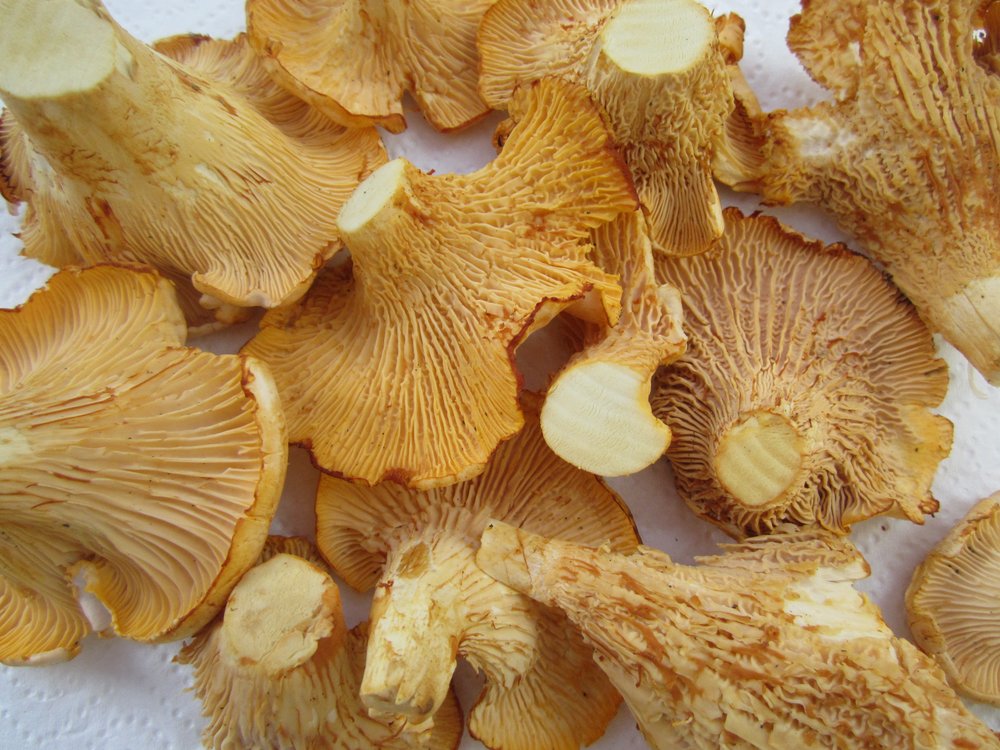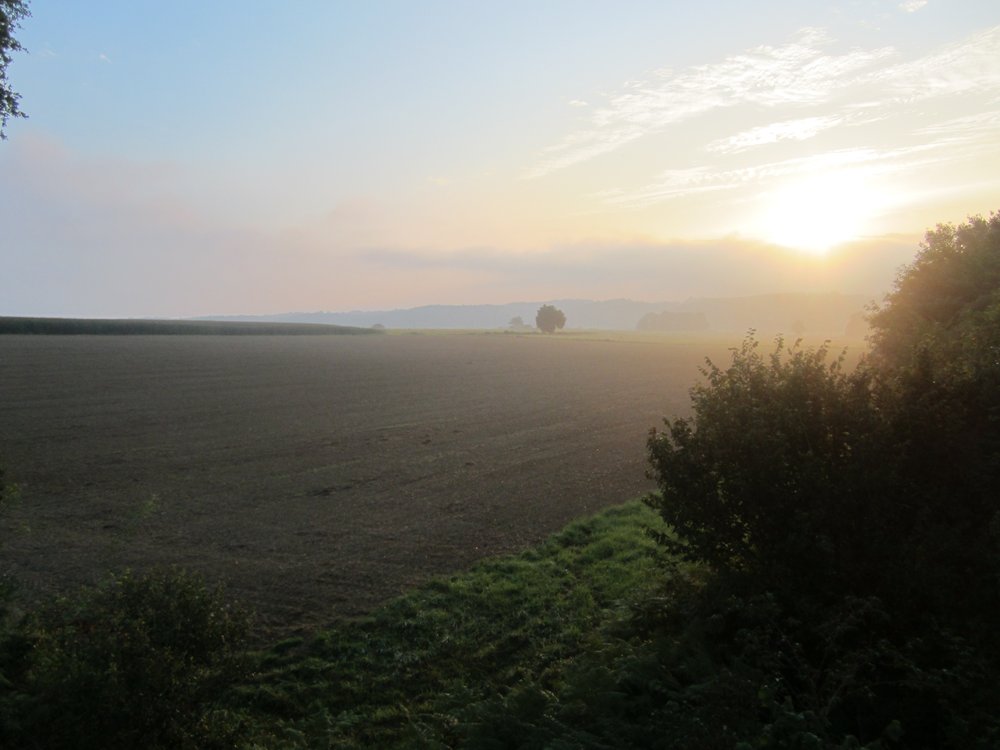 girollesThe dirt path through the woods is shaded and quiet. My sister and her family are ahead of me as I poke along slowly, looking for birds and other creatures. I pass the woods where the night before Claude Lucantis took me looking for mushrooms. I have an uncanny ability to find the most poisonous ones. But I did find a few girolles, golden orange, fluted, which we ate in a delicious omelet, and Claude found some cepes, which we fried up with garlic and duck fat.
girollesThe dirt path through the woods is shaded and quiet. My sister and her family are ahead of me as I poke along slowly, looking for birds and other creatures. I pass the woods where the night before Claude Lucantis took me looking for mushrooms. I have an uncanny ability to find the most poisonous ones. But I did find a few girolles, golden orange, fluted, which we ate in a delicious omelet, and Claude found some cepes, which we fried up with garlic and duck fat.
The dirt path is bumpy and barely used by farmers coming to cut wood. A few open fields deep in the woods are used to graze cattle. The woods are filled with chestnut trees, the green spiny fruit dangling, beech trees, some holly. The land in the woods is often terraced, a reminder that this region was mostly vineyards until phylloxera destroyed the vines in the late nineteenth century.
Near the house that is now owned by two Dutch women, we turned right. The day before we had visited the women, who have set up shop to make cheese here in this isolated patch of French soil. We had heard of these two for the ten years since they moved in—that they are Dutch is a novelty in an area where the British have come to settle. But more, that they are a couple has pretty much everyone talking. “We’ve seen everything here in Estampes,” Odette says clapping her hands and laughing. But newcomers to the area are scrutinized. Odette knows this as her husband Stanis, came from Polish stock: Baczkowski. She was ostracized from her family for marrying a Pole, who was more French than some Frenchmen.
 Green woodpeckers are common in France. But not so common that I’ve been able to see one in the ten days that I have been here. And I want to see one. Something about woodpeckers I find fascinating, and the names help. When I saw a three toed woodpecker (really, three toes?) in Maine, I was thrilled. When this past Christmas Peter and I saw a black woodpecker in the forest of Fontainbleau outside of Paris it was the highlight of the trip (not, as some might think, visiting Notre Dame…). So a green woodpecker was my goal for the morning as I rose at 6—the world still dark and quiet—and was out before seven. I walked south out of town, a winter wren singing to me from a bush that has taken over the courtyard of the abandoned house that once belonged to Francine. In the freshly cut field to one side I see a fox trotting my way. It’s tail is thick, a dark red, lined with brown. It doesn’t see me, so I stand still, and watch. I can tell what route it intends to take, out of the field, across the road and into the corn. So I pull out my camera and wait until it is mid-road. As I snap the photo, he becomes aware I am there, and picks up his pace as he moves into the corn and vanishes so fast.
Green woodpeckers are common in France. But not so common that I’ve been able to see one in the ten days that I have been here. And I want to see one. Something about woodpeckers I find fascinating, and the names help. When I saw a three toed woodpecker (really, three toes?) in Maine, I was thrilled. When this past Christmas Peter and I saw a black woodpecker in the forest of Fontainbleau outside of Paris it was the highlight of the trip (not, as some might think, visiting Notre Dame…). So a green woodpecker was my goal for the morning as I rose at 6—the world still dark and quiet—and was out before seven. I walked south out of town, a winter wren singing to me from a bush that has taken over the courtyard of the abandoned house that once belonged to Francine. In the freshly cut field to one side I see a fox trotting my way. It’s tail is thick, a dark red, lined with brown. It doesn’t see me, so I stand still, and watch. I can tell what route it intends to take, out of the field, across the road and into the corn. So I pull out my camera and wait until it is mid-road. As I snap the photo, he becomes aware I am there, and picks up his pace as he moves into the corn and vanishes so fast. Green woodpeckers are common in France. But not so common that I’ve been able to see one in the ten days that I have been here. And I want to see one. Something about woodpeckers I find fascinating, and the names help. When I saw a three toed woodpecker (really, three toes?) in Maine, I was thrilled. When this past Christmas Peter and I saw a black woodpecker in the forest of Fontainbleau outside of Paris it was the highlight of the trip (not, as some might think, visiting Notre Dame…). So a green woodpecker was my goal for the morning as I rose at 6—the world still dark and quiet—and was out before seven. I walked south out of town, a winter wren singing to me from a bush that has taken over the courtyard of the abandoned house that once belonged to Francine. In the freshly cut field to one side I see a fox trotting my way. It’s tail is thick, a dark red, lined with brown. It doesn’t see me, so I stand still, and watch. I can tell what route it intends to take, out of the field, across the road and into the corn. So I pull out my camera and wait until it is mid-road. As I snap the photo, he becomes aware I am there, and picks up his pace as he moves into the corn and vanishes so fast.
Green woodpeckers are common in France. But not so common that I’ve been able to see one in the ten days that I have been here. And I want to see one. Something about woodpeckers I find fascinating, and the names help. When I saw a three toed woodpecker (really, three toes?) in Maine, I was thrilled. When this past Christmas Peter and I saw a black woodpecker in the forest of Fontainbleau outside of Paris it was the highlight of the trip (not, as some might think, visiting Notre Dame…). So a green woodpecker was my goal for the morning as I rose at 6—the world still dark and quiet—and was out before seven. I walked south out of town, a winter wren singing to me from a bush that has taken over the courtyard of the abandoned house that once belonged to Francine. In the freshly cut field to one side I see a fox trotting my way. It’s tail is thick, a dark red, lined with brown. It doesn’t see me, so I stand still, and watch. I can tell what route it intends to take, out of the field, across the road and into the corn. So I pull out my camera and wait until it is mid-road. As I snap the photo, he becomes aware I am there, and picks up his pace as he moves into the corn and vanishes so fast.
